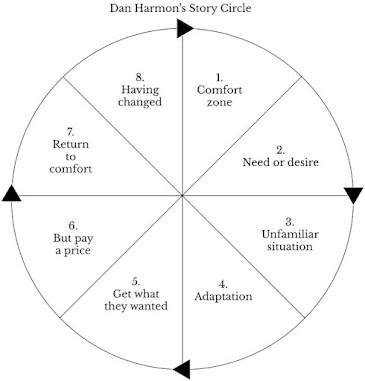Last week I began a series on story circles, which I think are great baselines to set our stories on because they align so closely with what we (as humans) expect a story to be. There are instances, of course, when we'll want to break those boundaries to surprise our readers, but it *is* helpful, before we start breaking rules, to know them and the structures readers most relate to.
I started with Joseph Campbell's monomyth/hero's journey, but I was recently introduced to Dan Harmon's story circle, and this one, to me, falls more in line with contemporary storytelling and character journeys/arcs.
Harmon's circle is closely related to Campbell's, though, and you can see some of the overlap even if the stages aren't exactly the same.
So we start with THE COMFORT ZONE.
This is the place the character knows. This is her familiar territory--life as it is.
Not long after this comfort zone is established, we learn about her NEED (or DESIRE). This is the discovery of a goal she may have (whether the goal is thrust upon her or appears of her own volition is up to the writer).
In order to accomplish this goal, she will now need to enter an UNFAMILIAR SITUATION. At this point, she steps wholly out of her comfort zone in a brand-new "world," and we--the readers--get to watch her flail about as she finds her footing.
This becomes her struggle as she tries to ADAPT.
At first, of course, a character is going to go about getting what they want in all the wrong ways, but this unfamiliar territory and their desperation to adapt is going to do a lot of heavy lifting when it comes to filling those story pages. This is the bulk of your story, and where those obstacles build to a point of no return.
Finally, the character will GET WHAT SHE WANTS.
But . . . she will PAY A HEAVY PRICE or suffer to some degree for what she's gained because this isn't what she needed . . . not really . . . not until she can finally take her newfound knowledge and RETURN TO COMFORT with the CHANGES she's made.
Like many story circles, this begins with a Familiar Order, moves into Chaos, then returns to a New Order.
So there's a cute movie on Netflix right now called He's All That. I am of the She's All That era, so, naturally, I wanted to see what this updated gender swap looked like. Not only did I enjoy it, but the plot fits into Dan Harmon's circle beautifully.
1) THE COMFORT ZONE
Padgett is a social influencer pretending to be wealthier and more "together" than she really is to keep up appearances.
After her celebrity boyfriend cheats on her and her reaction/breakdown is caught on a Livestream, her social status plummets. (This is the catalyst.)
2) NEED OR DESIRE
She needs to win her followers (and sponsors) back . . .
3) UNFAMILIAR SITUATION
. . . so she makes a bet to turn the least popular boy in school into the prom king.
4) ADAPTATION
Padgett and Cameron begin to bond as she slowly makes him over.
5) GET WHAT THEY WANTED
Cameron is becoming more accepted . . .
6) PAY A PRICE
. . . but soon she and her plans are outed publicly. Now she's lost Cameron (whom she was really beginning to like) and a "best friend" (who was actually an enemy) and everyone knows her "influencer life" was not her reality.
7) RETURN TO COMFORT
She goes to prom--which doesn't even matter to her anymore--and back to her life (without Cameron) realizing . . .
8) HAVING CHANGED
. . . what a massive mistake she's made and how she's been focusing on all the wrong things. Cameron realizes he, too, has changed and forgives Padgett. They are finally together and, post-high school, are traveling so he can work on his photography and she can be a new kind of (better) influencer.
Sure it's a light, cheesy, YA rom-com, but it works.
What's so nice about Harmon's circle? It's emotion-centric, in a lot of ways. Can we apply a story's plot to it? Absolutely. But we can also apply our character arcs to it.
In He's All That, Cameron is undergoing his own changes. He has a need/goal and is thrust into a new situation he must adapt to (namely Padgett's interference in his life), but he, too, grows/matures by the end.
Ergo, filling out one of these circles for each of your main characters will help deepen their interactions with one another as well as the impact they make within the overall story, satisfying the reader on multiple levels.
Be Brilliant!
~Katie~



